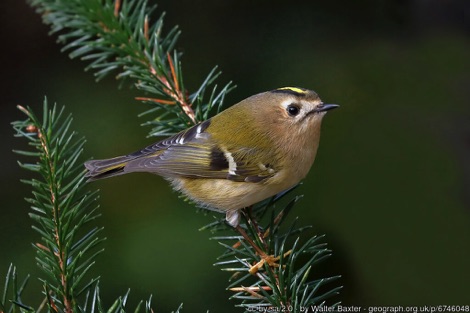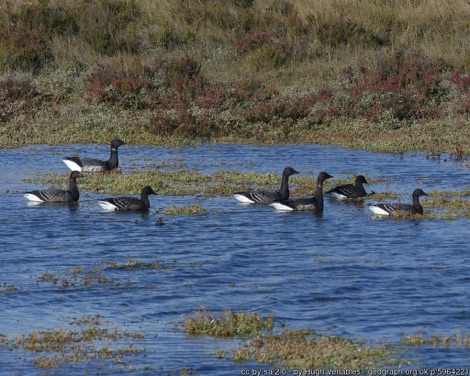
Here are some of the best places to see visiting winter birds across the RSPB reserves network in the UK
Green Adventures November 2025
Winter visitors
Whilst the closing quarter of the year brings a sense of seeking comfort indoors, the colourful, energetic presence of so many migratory bird species gives us plenty of good reasons to head outdoors to appreciate them.
Many species make gruelling, lengthy journeys down to the UK in search of a warmer reprieve from the harsher winters of places such as Iceland, Scandinavia and Northern Russia. Food sources are also a crucial consideration, with much of England's East Coast wetlands habitats providing water birds with a safe haven, and the fish, molluscs and plants that are so vital to their diet.
Here are some of the key species visiting the UK as autumn migrants – and the RSPB nature reserves to visit to give you the best chance of seeing them in action.
Click here for more information about RSPB nature reserves.
Goldcrest
The daunting journeys made by most migratory birds can seem against-the-odds, but spare a thought particularly for the tiny goldcrest (pictured above). This is the UK's smallest bird, weighing little more than a 20p piece. The goldcrest's small size makes it particularly susceptible to extremes of weather, so each year our resident population is joined by migratory birds making their way across the North Sea from Scandinavia for the UK's more temperate winters.
Where to see them
Mature woodland and parks, especially with conifer trees. RSPB Arne, Dorset, England, usually enjoys good numbers over winter.

Fieldfare
These large thrushes arrive in the UK in search of bushes and trees laden with winter fruit, such as hawthorn, holly, rowan and apple trees. A sociable species, look for Fieldfares gathered in noisy flocks, or listen out for their 'chack-chack' call.
Where to see them
Woodland and places with lots of trees still bearing fruit through winter. RSPB Ynis-hir, Wales, is often a good spot to look for them.

Starlings
Whilst starlings are resident in the UK year-round, each November to February sees their numbers swell, as many more birds migrate here from Scandinavia. Their roosting habits create one of nature's most enduring winter spectacles, the starling murmuration. Often seen just before dusk, a starling murmuration is formed of thousands of birds that swoop and dive en masse, often creating breath-taking shapes in the sky. The reason for the spectacle is still up for debate – but there's no doubt that in part it helps deter predators. Roosting together also provides safety and warmth.
Where to see them
RSPB Leighton Moss, Lancashire; Minsmere, Suffolk; and Saltholme, Cleveland. All these RSPB reserves usually have large numbers of starlings through winter – but, like any wildlife sightings, murmurations are never guaranteed.

Brent geese
One of the smaller, darker sub-species of geese, brent geese are distinctive in flight for their preference for loose flocks instead of a tight skein formation. If you spot brent geese during winter in the UK, slight differences in their plumage can give you an indication of where they've travelled from – birds who breed in Northern Russia, Alaska or Canada have darker bellies, whilst any with lighter colouring on their underside are likely to have joined us from Svalbard and Greenland.
Where to see them
Titchwell Marsh, Norfolk.

Redwings
Like fieldfares, redwings will spend a UK winter in hungry pursuit of berries and other winter fruits. Our smallest true thrush, redwings can be harder to spot due to their skittish temperament – your best chance is when they are gathered on a bush or tree, completely absorbed in feeding.
Where to see them
In search of food in wooded areas. RSPB Old Moor, South Yorkshire, and RSPB Loch Lomond, Scotland, usually enjoy lots of these winter visitors.

Pink-footed geese
These medium sized geese are easiest to spot from their distinctive pink legs, from which they take their name. They come to the UK from breeding sites in Spitsbergen, Iceland and Greenland, particularly in search of post-harvest cereal stubbles, sugar beet-tops and winter wheat crops. Encouragingly their overwintering numbers in the UK are increasing, particularly in Norfolk – probably due in part to better protection at their winter roosts.
Where to see them
RSPB Snettisham, Norfolk; Leighton Moss, Lancashire; and Loch Leven, Scotland.
Ads/Affiliate links
Green Adventures is a non-profit online magazine sharing articles and news about nature, rewilding, history, culture and the great outdoors. If you like our content, please help keep us going with a small donation!
